This summer we once again had the exciting opportunity to conduct research at the world’s largest furry convention: Anthrocon. In addition, building upon the success of our last international online survey, we carried out the survey both at Anthrocon and (about a week later) online. Participants were thus furries from all over the world, completing the survey online, and participants at Anthrocon who we recruited through the simple method of “walking through the line-ups and offering people a chance to do the survey as something to do.” In total, we received nearly 2,000 participants from 41 different countries (after removing minors from the sample, as our ethics board prohibits us from conducting research on minors). Our sample consisted of 1,761 furries and 179 non-furries.
A number of new items were included in the survey this year, based on questions and feedback from furries regarding the kinds of issues they were interested to know more about and based on various psychological theories being tested by the researchers. Included in these new items were questions on the subject of therians/ otherkin, sexual attraction/ love / behavior, family statistics, relationship to one’s fursona species, new species questions, subgroups within the furry community, attitudes towards various furry issues, questions about artists and writers, fursuit ownership, factors influencing joining the fandom, personality, belief in magic or supernatural forces, and how the furry fandom interacts with one another. These were in addition to many of our usual questions.
In sum, the survey consisted of nearly 250 questions. It would be prohibitively long and tiresome to go over the results of each of these questions individually, and so below are some of the more interesting summaries of the data which has thus far been analyzed.
As always, if you have any questions or want clarification, please contact us (see link on the sidebar).
Please note that all collected information is presented here in aggregate (summarized) form, and there is absolutely NO identifying information in the data. We have no way of tracing responses back to the original participant (this is an anonymous survey). Additionally, any unique responses (e.g. species types selected by only one person) are not reported, to protect the anonymity of the participants.
Summary of questions:
Demographics
Q1: How much of your sample came from online/Anthrocon 2011?
Q2: Where did the furries in your sample come from?
Q3: How old is the average furry?
Q4: What is the ethnic breakdown of the furry fandom?
Q5: What is the sex breakdown of the furry fandom?
Q6: What is the gender breakdown of the furry fandom?
Q7: Sexual orientation in the fandom: Are furries gay, straight, bisexual, or something else?
Q8: Furry sexuality: Behaviour, attraction, and love: the same thing?
Q9: Are furries mostly single or in relationships?
Q10: What kind of families do furries come from?
Q11: What kind of education does the average furry have?
Furry Statistics
Q12: How “furry” is the average furry?
Q13: How long has the average furry been a furry for?
Q14: How much of your sample was furry? Therian? Otherkin?
Q16: Is there a difference between a “furry” and a “furry fan”?
Q17: Is furry something you are, or something you do?
Q18: How many furries own fursuits?
Q19: How did furries come to associate with the furry community?
Q20: What “makes” furries “furry”?
Q21: What are furries like, personality-wise?
Species Questions
Q22: How many fursonas has the average furry had?
Q23: What is the relationship between furries/ therians and their “fursona” species?
Q24: Do furries choose predator or prey species?
Furry Community
Q25: What exactly is “furry culture”?
Q26: What are the attitudes of furries towards various furry subcultures?
Q27: What interests do furries have?
Q28: How many artists/ writers are there in the fandom?
Q29: How close do furries feel to the furry community?
Q30: How big is the furry fandom?
Q31: How do furries interact with one another?
Furry Well-Being
Q32: Are furries maladjusted or well-adjusted?
Demographics
Q1: How much of your sample came from online/Anthrocon 2011?
In this survey, approximately 55% of our sample (N = 1,154) came from online sources (e.g. Wikifur, local furry forums, Flayrah, Furry News Network, etc…), while approximately 45% of our sample (N = 877) came from respondents at Anthrocon, 2011.
Q2: Where did the furries in your sample come from?
As in previous surveys, the vast majority of our participants came from the United States. However, there were a number of participants from all over the world, making our survey an international one. It should be noted that although our sample drew quite heavily from North America, there are a number of reasons for this, including the sample being partially drawn from an American furry convention, and the fact that the survey was only in English, which likely excluded a significant number of furries from the international community.
Q3: How old is the average furry?
While it is true that the furry community is a young and vibrant community, it is also true that the community is a very diverse one, with furries of all ages attending conventions and participating online and at local furmeets. As the distribution below shows, approximately 70% of our sample was 25 years old or younger, a number which very likely underestimates the number of “under 25” furries, given that minors were ineligible to participate in the survey.
Interestingly, between 5-10% of the fandom reports being a part of the furry community well into their 40s, 50s and 60s.
Q4: What is the ethnic breakdown of the furry fandom?
As has been in the case in our previous surveys, the majority of participants in our survey self-identify as white. There are, nonetheless, a multitude of racial and ethnic groups within the furry fandom, as seen below.
It should again be noted that, given the North American nature of this sample, it is unsurprising that the majority of participants were white. With translations into multiple languages, it should be possible to tap into parts of the furry community which, for the time being, are more difficult to access due to language barriers.
Q5: What is the sex breakdown of the furry fandom?
As has been the case in past years, the majority of the furry fandom is male. To elaborate on previous findings, we decided to look at whether there was a difference between furries and therians (see questions 14 & 15 below) in terms of biological sex.
Interestingly, there appear to be slightly more females in the therian sample than in the furry sample. Even more interestingly, there are more than three times as many transgendered participants in the Therian sample as there were in the furry sample. It is difficult to draw conclusions on exactly why there may be differences between these two samples, but future research may suggest reasons for these differences.
Q6: What is the gender breakdown of the furry fandom?
It is important to note that there is a tremendous difference between biological sex and gender. Sex is biological, based on genetics/ chromosomes or on physiology (depending on whose definition one chooses to use). Gender, on the other hand, is a social construction, a product of how a person is raised, the environment around them and how they see themselves. As such, it is entirely possible for a biological male to describe themselves as “feminine”, and for biological females to self-identify as “masculine”.
We asked participants to identify how masculine or feminine they considered themselves on a 5-point scale (1- Male, 3 – Male/Female, 5 – Female), with an option for “Other”. As you can see below, while more than 80% of the furry sample reported being biologically male, only about 45% of the sample identified with the male gender. Additionally, while 15% of so or of the furry sample identified as biologically female, less than 10% of the sample identified with the female gender. This suggests, perhaps unsurprisingly, that sex and gender are not one and the same, in particular among the furry community.
In a follow-up analysis we asked participants to identify whether or not their fursonas were the same gender as they were (1), sometimes different (3), or a completely different gender (5) from their own, non-fursona gender. We looked at this for both males and females. We found a significant degree of gender-bending with regard to one’s fursona gender, with between 35% and 48% of furries reporting at least some degree of difference in their fursona’s gender. We then looked at the difference between biological males and females on this willingness to have a fursona of a different gender than their own. We found a statistically significant difference between males and females, such that female furries were more likely than male furries to have a fursona that was a different gender than their own.
Q7: Sexual orientation in the fandom: Are furries gay, straight, bisexual, or something else?
The data on sexual orientation of furries replicates our past findings, finding that the sexual orientation of furries is distributed quite a bit across the entirety of the sexual orientation dimension. In particular, our sample showed that there were about 1.5 times as many exclusively heterosexual furries as there were exclusively homosexual furries in the fandom, while nearly 50% of the fandom reported a sexual orientation that was somewhere in-between exclusively heterosexual and exclusively homosexual. It was also found that females were statistically significantly more likely to be heterosexual than males in the fandom. There were also 5-7% of furries who identified themselves as “asexual”, “pan-sexual” or “other”.
As we did in the last survey, we also had participants rate the sexual orientation of their fursonas. Supporting our previous findings, we again found that furries, on average, tended to have fursonas that were slightly more homosexual than they were. There are a number of possible reasons for this (e.g. perhaps a fursona is a convenient way for a furry to “test the water” or experiment with homosexuality). Future research may help us to test whether or not this explanation, or others, can explain this consistent finding.
Q8: Furry sexuality: Behaviour, attraction, and love: the same thing?
In addition to our questions about sexual orientation, we also asked furries more specific questions about the way in which their attraction to others manifests itself. In particular, we asked participants to identify, on 0-6 scales, the extent to and frequency with which they had been attracted to, physically intimate with, and in love with others of both the same sex and the opposite sex. As the results below seem to suggest, there are some small, but statistically significant differences between furries and our non-furry control sample. In particular, it seems to be the case that non-furries reported being slightly more attracted to members of the opposite sex, slightly more physically intimate with the opposite sex, and had been in love with more members of the opposite sex than furries. In contrast, furries were more physically intimate with and had been in love with more same sex partners than non-furries. This is, perhaps, unsurprising, given that there is a greater proportion of homosexuals and bisexuals in the furry fandom than there are in the general population. As such, there does not seem to be clear-cut evidence to suggest that furries are any more or less sexual than our non-furry control group.
Q9: Are furries mostly single or in relationships?
To answer the question of whether or furries are mostly single or in relationships, it is important to look at the biological sex of the furry in question. As the data below suggest, sex is an extremely important variable to consider: male furries are more than twice as likely as female furries to be single, and female furries are three times more likely to be married than male furries.
Q10: What kind of families do furries come from?
A new set of questions this year involved asking participants questions about their families.
We asked furries whether or not their parents had even been divorced; this was due to the suggestion of several furries that one of the “causes” of being a furry was because of family problems. There was no evidence to support this claim, as there was no significant difference between furries and non-furries in terms of how frequently their parents were divorced. Specifically, 33.6% of furries reported that their parents had been divorced.
With regard to the number of siblings they had, the average furry reported having 1.7 siblings. Interestingly, of furries with at least 1 sibling, the majority reported being the oldest child (47.5%) rather than the youngest child (34.5%), while 18.0% of furries reported that they were a middle child. Approximately 15% of furries reported being an only child.
Q11: What kind of education does the average furry have?
As with previous surveys, we asked participants to indicate their level of education. And, as with previous surveys, it was found that the average furry reported at least some college or university education, with approximately 75% of furries indicating having attained or being in the process of attaining post-secondary education.
Furries were also asked to indicate, if they had completed post-secondary education, what area/field the education was in. When the data was coded by research assistants, it was found that 24.2% of furries had chosen degrees in a field that could be considered an “art” (e.g. design, graphics, writing). In addition, 27.9% of furries had chosen fields that directly involved computers (e.g. computer graphics, computing science, information technology, computer engineering). 11.9% of furries selected a degree that could be considered specifically a “science” degree (e.g. biology, chemistry, physics) and 11.9% had taken a degree in some form of engineering.
Furry Statistics
Q12: How “furry” is the average furry?
We asked participants (furry and not) to indicate, on a scale of 1-10, how much they considered themselves a part of the furry fandom. Unsurprisingly, furries were far higher on this measure than non-furries, as indicated below, with an average of 7.21 compared to 3.60. While these results may not seem particularly interesting, it is worthwhile to note that they say something important about our non-furry control group: they did, on average, consider themselves at least somewhat a part of the fandom. Given that our non-furry participants consisted of either people at Anthrocon 2011 or recruited online from furry websites, we have to be careful when interpreting results, as they are not a perfect control group. We can assume they know what furries are, and that they are at least somewhat amiable to the furry fandom (given their presence on furry websites or at furry conventions). In light of this, our future studies will include non-furry participants recruited from other locations (e.g. malls, university classes, other conventions).
Q13: How long has the average furry been a furry for?
The average furry in our sample reported that they had considered themselves to be a furry for between 7 and 8 years. Interestingly, Anthrocon participants reported having considered themselves to be a furry for statistically longer than online participants (8.4 years versus 7.0 years). This is likely a product of the Anthrocon sample being older (25.8 years versus 24.0 years), which is likely a product of the fact that older furries are more likely to have stable, better-paying careers and thus have the means to afford to attend a convention.
The average furry reported that they considered themselves to be a furry for the first time, on average, at about the age of 17. On average, they reported that they became a part of the furry community 2 years later, at about the age of 19. Again, as has been seen in our past research, there is an approximately 1.5-2 year gap between the time a furry considers themselves to be a furry and when they find the community. This can have many implications for people in this transition stage, where they may feel they are different, but searching for (or oblivious to the existence of) a community of like-minded individuals.
Q14: How much of your sample was furry? Therian? Otherkin?
A number of furries have given us feedback on our past surveys, asking us to investigate therians as a group. While the definition of therian may differ depending on who you ask, it can be loosely defined as people who believe that they are not entirely human. This can manifest itself in different ways; for some, as possessing the spirit of an animal trapped within a human body. For others, it can be expressed as “some part of me is best expressed by something non-human”. For the purpose of our research, it is not necessary to define “therian”, but instead to handle it the same way we handle the definition of “furry”: if a person self-identifies as a therian, they are a therian.
We asked participants whether they self-identified as a furry. We also asked them whether they self-identified as a therian or as an otherkin – a term related to therian, though tending to be associated with mythical creatures.
From the results below, it is apparent that the furry fandom, far from being a simple matter of “furry or not”, contains upwards of 20% therians and otherkin.
Q16: Is there a difference between a “furry” and a “furry fan?”
There has been some debate about terminology in the fandom. One such debate revolves around the use of “furry” and “furry fan”, and whether these two terms are referring to the same thing or to two completely different groups of people.
We asked participants to explain whether or not they believed there was a difference between a furry and a furry fan. The results below suggest that a majority of the furry community does believe that there is a distinction between a furry and a furry fan. We asked a follow-up question, asking furries to explain, if they thought there was a difference, what the difference is. That data is currently being coded and analyzed, but a preliminary glance suggests that some of the perceived differences may involve perceived degree of involvement in the community (whether you spend a lot of time/ money/ effort on the furry community or not) or arguments of producing versus consuming (whether you create content for/ engage in the community or passively observe/ consume content within the community). Further analysis may help us to figure out which of these possible explanations, or others, may explain why furries consider these two groups distinct.
Q17: Is furry something you are, or something you do?
For some members of the furry community, furry can be best described as something they are, a means of self-expression or a description of who they are. For others, the furry community is something they engage in, an activity they engage in (often for recreation). For still others, involvement in furry is a mixture of both, or neither.
The results below suggest that, in general, a majority of the furry community believes their involvement in furry to be a mixture of both of these (it’s both an expression of self and an activity they engage in). More participants exclusively believe that furry is something they are rather than something they engage in, and therians are significantly more likely than furries are to endorse this belief.
Q18: How many furries own fursuits?
An often-debated question among the furry community is the question of the popularity of fursuiting. Given that, in popular culture (and sometimes among the community itself), furry is often reduced to “fursuiting”, it is important to understand just how prevalent fursuiting is to appreciate that, while certainly a component of the community, fursuiting is certainly not the entirety of the furry community.
We asked participants to answer several questions about fursuit and furry paraphernalia ownership. In particular, for each one, we asked furries to identify whether they, indeed, did own it, whether they did not yet own it (but intended to), whether they did not own it, did not own it and probably would never own it (for whatever reason), or whether they did not own it and did not want to own it. This question was asked with regard to owning a full fursuit (defined as including a head, paws, torso and tail, where applicable), to owning a partial fursuit (defined as owning at least two or three of the above items), or to owning furry paraphernalia (ears, tail, paws, clothes, buttons, etc…)
The results indicate that only about 10-15% of the furry fandom actually owns a fursuit (though the results also indicate that far more, nearly 50%, indicate an interest in acquiring one). Additionally, only about 25% of furries actually owns a partial fursuit (again, with many more indicating an interest in owning a partial fursuit in the future). Finally, a majority of furries own some form of furry paraphernalia.
Taken together, these data suggest that, far from the common misconception of the furry community as consisting primarily of fursuiters and those who want fursuits, it is clear that many in the fandom are completely uninterested in the prospect of ever owning a fursuit, partial or otherwise, and that the vast majority of the furry community does not own a fursuit. For some, this is simply a matter of pragmatic reasons, such as cost or a lack of occasion to wear the suit. For many, however, they have indicated that a fursuit is simply not the way their interest in anthropomorphism manifests itself, and instead cite other ways their interest manifests itself (e.g. artwork, spiritual beliefs, writing, mannerisms, etc…).
Q19: How did furries come to associate with the furry community?
We were particularly interested in the factors which drew people to furry in the first place. Specifically, is a person’s interest in furry (and their willingness to seek out the furry community) driven primarily by a feeling inside of them (often expressed by statements such as “I just always was a furry” or “I was a furry, I just didn’t know it”), or was it driven by a discovered interest (often expressed by statements such as “A friend introduced me to it and I was hooked” or “I discovered furry on the internet and wanted to be a part of it”)?
Our data suggest that, for approximately 45% of furries, a combination of something within them (e.g. a long-standing interest in anthropomorphism) in conjunction with an exposure to the furry community (e.g. seeing a website or being introduced to the furry community by a friend) best describes how they came to associate with the furry community. Our data also suggest, however, that therians/otherkin are about twice as likely as furries to report that a feeling within them was the biggest influence on their association with the furry community, and are about half as likely as furries to report that an outside influence was the driving force to their association with the furry community.
Q20: What “makes” furries “furry?”
Over the years we have had a number of conversations with members of the furry community (and non-furries) who have speculated about what “makes a furry a furry”. A number of furries cite a specific movie from their childhood or a particular memory. Many report that, as far as they could remember, it was a feeling inside of them for as long as they could remember.
We asked participants to indicate, on a 7-point scale, the degree to which each they felt that 14 different factors influenced their becoming a member of the furry community (1 – Not at all an influence, 7 – Very important influence). The result: while there are clearly some factors that are far more common (e.g. the internet, a feeling inside, exposure to artwork) and far less common (e.g. having a pet, another fandom), there are a myriad of different forces which lead people to the furry community. This often flies in the face of popular conceptions of the furry fandom as portrayed by the media or my some members of the fandom, who would like to claim that any one factor is the sole cause of more furries than any other.
Q21: What are furries like, personality-wise?
There are a number of different models of personality in the psychological literature, but one of the most frequently cited is the “Big 5” model of personality, which proposes that there are five major dimensions along which people’s personality differ: a) Extraversion: the tendency to be energized by and seek out the presence of others, b) Agreeableness: Being of friendly, cooperative, and social nature, c) Conscientiousness: the extent to which one is organized and mindful of goals, d) Emotional Stability (inversely known as Neuroticism): Confidence and resilience, lack of susceptibility to negative emotions, e) Openness to experience: A curiosity or interest in what is unconventional, or a desire to see, taste, hear and immerse oneself in a variety of sensations and situations.
We assessed each of these items in participants using a small, 10-item personality scale. We then conducted an analysis to see whether the degree to which a person considered themselves a furry predicted their scores on these five personality traits (referred to as a regression analysis).
Our results indicated the following:
Extraversion: The more a part of the furry community a person was, the more extroverted they reported being.
Agreeableness: The more a part of the furry community a person was, the less agreeable they tended to be.
Conscientiousness: There was no statistically significant association of being a member of the furry community with conscientiousness.
Stability: There was no statistically significant association of being a member of the furry community with stability/ neuroticism.
Openness to experience: The more a part of the furry community a person was, the more open to experiences they tended to be.
Of course, each of these five personality factors consists of many different sub-factors. In future research, we would like to look at sub-factors within these five facets of personality to see if we can more specifically describe the personality of members of the furry community.
Species Questions
Q22: How many fursonas has the average furry had?
The average furry has had 2.12 fursonas in their life. There was no statistically significant difference in the number of fursonas furries reported having and the number of fursonas therians reported having (1.92).
Q23: What is the relationship between furries/therians and their “fursona” species?
We asked furries to answer a number of questions pertaining to the nature of their felt connection to their fursona/ chosen species, asking questions pertaining to their liking of their species, a felt spiritual connection to their species and their degree of identification with their chosen species (as indicated on a 7-point scale, 1 – Not at all, 7 – Very much). It was found, in general, that “liking” one’s species was the most common relationship between furries and their species. However, across all three types of felt connections, therians were found to have greater connections to their species than furries, especially when it came to spiritual connections and identification with their species.
Q24: Do furries choose predator or prey species?
Since a number of furries identify with their fursona/chosen species, we were interested in studying whether or not their fursona species were considered predator or prey. As you can see from the table below, predator species were the most popular species chosen. Additionally, among therians and otherkin, predator species are particularly common.
Interestingly, when we analyzed the differences between people who chose predator species versus those who chose predator species, a statistically significant difference was found, such that those who had chosen/identified with predator species were significantly more extroverted than those who had chosen prey species. This is the evidence we have that a person’s choice of fursona may reflect (or influence) their personality!
Furry Community
Q25: What exactly is “furry culture?”
Given the diversity of the furry community, it is unsurprising that there can be disagreement surrounding what exactly constitutes furry “culture.” Based on the suggestions from furries at a number of conventions and fur meets, a list of 14 different potential components of furry culture were tested. We asked participants to identify, on a 7-point scale, the extent to which they believed that each item was a part of furry culture (1 – Completely Disagree, 7 – Completely Agree). As you can see below, there are a number of factors which were nearly universally declared to be a part of furry culture (e.g. “Art”, “Community”, “Acceptance”), and others which, contrary to rumors and stereotypes, are not considered an important (or at least defining) part of furry culture (e.g. “Drama”, “Sex”).
Q26: What are the attitudes of furries toward various furry subcultures?
Similar to the above question, the furry fandom is comprised of a number of distinct subcultures, often reflecting the variety of different interests of individuals within the community.
However, some subcultures are more accepted by the furry community than others. Adding another layer of complexity to the puzzle, some subcultures feel more positively or negatively toward others, while other subcultures are universally liked or disliked.
We asked participants to indicate, on a scale from -3 (Very Negatively) to +3 (Very Positively), how they felt about each of the groups as a part of furry culture. It should be noted that the researchers do not, in any way, consider these results to be value judgments or to state that any group belongs or does not belong in the furry community. Instead, they are reported as reflecting the attitudes of the furry community in general toward different sub-groups within the community.
It may also be worthwhile to note that these data suggest that the stigmatization reported being felt by members of some sub-groups within the fandom may not be imagined or exaggerated.
Q27: What interests do furries have?
We were interested in the hobbies and interests of furries. Given that a number of panels and themes appear to be recurring at a number of different conventions, it made sense to look at these recurring themes to see whether they reflected the interests of the furry community as a whole.
We asked participants to indicate, on a 7-point scale, their interest in each of the following activities (1 – Not at all, 7 – Very much). As you can see, there is, again, a wide range of interests, though some (such as science fiction, video games, cartoons and webcomics) seemed to be more universal than others (e.g. sports).
Q28: How many artists/writers are there in the fandom?
Given the importance attributed to artwork within the fandom and the popularity of art/artist websites within the community, we were interested to know what percentage of furries considered themselves to be artists and writers. We asked participants to indicate, on a 7-point scale, the extent to which they considered themselves to be an artist and a writer (1 – Absolutely not, 7 – Completely).
The data below suggest that there is a wide variety of artistic/ writing skill within the fandom, with approximately 35% of the fandom claiming vehemently to not identify themselves as artists or writers, and another 25% or so claiming strongly that they are artists and writers.
Q29: How close do furries feel to the furry community?
We were interested in the extent to which furries and non-furries felt a sense of connection or inclusion within the furry and non-furry community. This was assessed using a scale called the Inclusion of Other in Self Scale (IOS). In this scale, participants indicated the amount of “overlap” that existed between themselves and another group (either the furry community or the non-furry community). Higher numbers indicate greater felt connection to the group.
The data below show firstly, and perhaps unsurprisingly, that non-furries consider themselves to be more connected to non-furries than to furries. Furries, on the other hand, felt pretty much equally connected to both furries and non-furries. And, interestingly, therians felt more connected to furries than to non-furries.
Q30: How big is the furry fandom?
While it is certainly not the most accurate way to gauge the size of the fandom, we were interested in the perceptions of furries about the size of the fandom. We asked furries to choose from a list of estimates about the size of the furry fandom (ranging from 1 in 1 million people to 1 in 10 people). On average, furries estimated that the prevalence of furries in the population was between 1 in 2,500 and 1 in 5,000 people, or about 1.4 – 2.8 million furries worldwide. The range of estimates varied considerably, given individual differences in the definition of “furry” and in whether or not a person could be “furry” and not realize it.
Interestingly, a regression analysis on the data found a relationship between the degree to which a person considered themselves a furry and their estimates of the community’s size. In particular, it was found that the more strongly one identified themselves as a member of the furry fandom, the greater their estimates of the number of furries in the world. This could represent any of a number of potential motivations or biases in judgment (e.g. a desire to “normalize” furries by seeing them as more prevalent in the fandom, or perhaps being a product of being in the fandom for longer and thus knowing more furries, which could increase their estimate of the number of furries).
Q31: How do furries interact with one another?
We were interested in studying the ways in which the furry community interacted with one another. Given the relative rarity of furries (compared to the population in general), it is interesting to note the varied ways in which furries have sought one another out and have maintained a strong, closely-knit community in spite of distance and their relative rarity (for example, being the only fur in a small town).
We first asked participants to rate their agreement on a 7-point scale with a number of items (1 – Completely disagree, 7 – Completely agree) pertaining to the nature of their interaction with the furry community.
Participants indicated that the majority of their interactions with other furries were online (5.55) as opposed to at local furmeets (2.98) or conventions (3.16). Additionally, many furries agreed that the majority of the furs they knew did not live in the same city as they did (5.08).
Finally, we asked a series of questions asking furries to indicate the frequency with which they interacted with furries in a number of different contexts. As is evident from the data below, the majority of furries’ interactions with one another tend to be over the internet, either through instant messaging programs, on on forums. It also suggests that about 50% of our sample regularly attended furry conventions. Of course, the above results need to be taken with an important caveat: our data were collected from both online samples and convention-going samples, and thus can be expected to have some influence on these data.
Finally, we found evidence that approximately 40% of furries interacted with one another with at least some frequency on sites such as Second Life or IMVU, with such near-daily interactions being a part of the social lives of 15-20% of furries. It was also found that therians were significantly more likely to use Second Life or IMVU than non-therian furries.
In sum, these data suggest that the furry community has a strong, vibrant presence on the internet and that, for many, online interaction serves an important function in their social life and plays and is critical to facilitating their interaction with the furry community.
Furry Well-Being
Q32: Are furries maladjusted or well-adjusted?
Data from our previous surveys found no evidence to suggest that furries were maladjusted or any better adjusted than non-furries with regard to self-esteem or life satisfaction. Results from this survey replicated those findings, suggesting no statistically significant differences between furries, therians and non-furries as measured by self-esteem scales and depression scales. As such, we have again found no evidence to support the claim that furry represents some maladjustment or problem, as furries seem to lead just as fulfilling lives and be just as happy with themselves as non-furries.

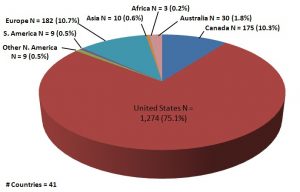
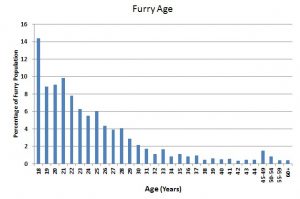
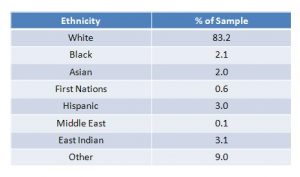

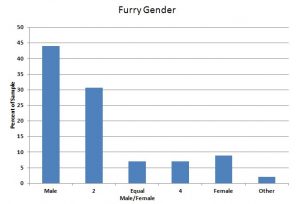

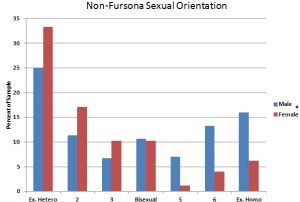
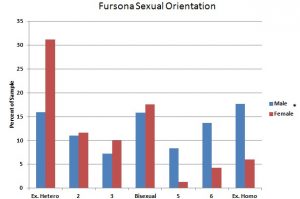
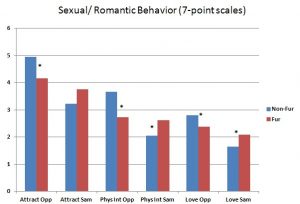
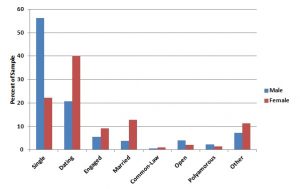
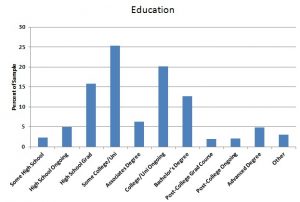

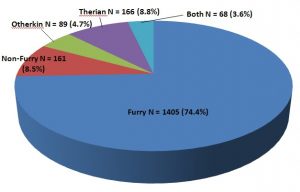
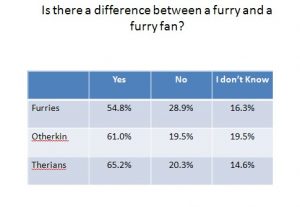

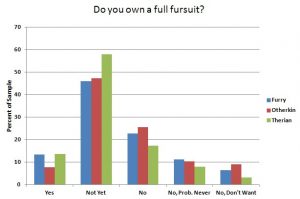
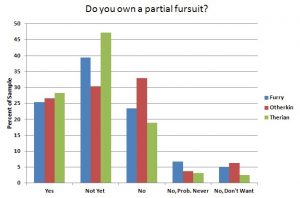
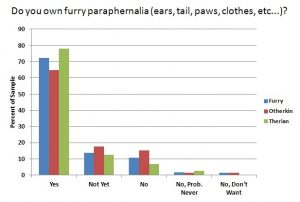

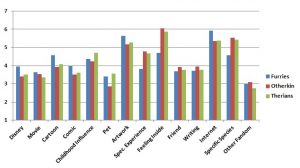
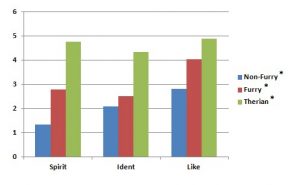
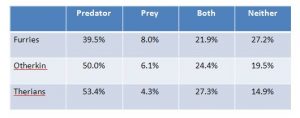
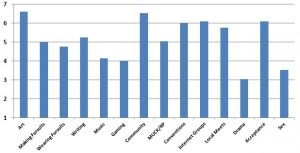
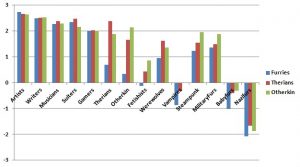

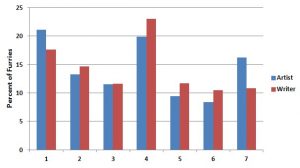
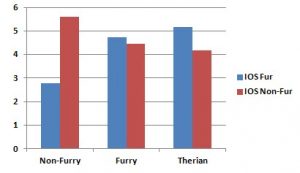
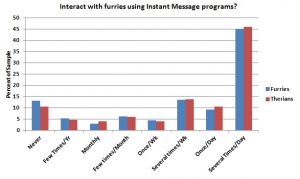

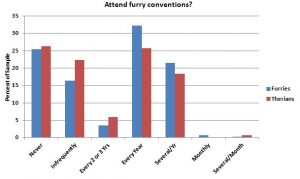
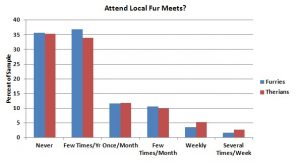
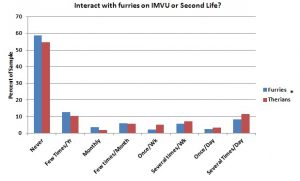
Recent Comments